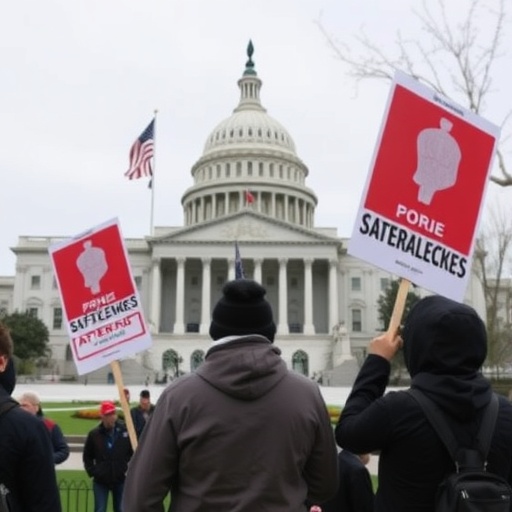Government Shutdown Enters Fourth Week: Federal Employees Go Unpaid, SNAP Benefits at Risk
As the U.S. government shutdown stretches into its fourth week, hundreds of thousands of Federal Employees are staring down the barrel of financial ruin, with paychecks stalled and essential services teetering on the brink. This prolonged shutdown, triggered by partisan disputes over border security funding, has left an estimated 800,000 workers without full salaries, including the very staff who support lawmakers in Congress. The ripple effects are already hitting hard, from delayed air travel to looming threats against critical programs like SNAP, the Supplemental Nutrition Assistance Program that feeds millions of low-income families.
At the heart of this crisis is the stark reality for Federal Employees, many of whom are resorting to food banks, credit card debt, and side gigs just to make ends meet. “It’s like living in a constant state of anxiety,” said Sarah Jenkins, a National Park Service ranger furloughed since December 22. “We’ve been told back pay is coming, but right now, bills don’t wait.” This isn’t just a Washington problem—it’s affecting communities nationwide, with economists warning of broader economic drags if the stalemate persists.
Lawmakers’ Aides Grapple with Irony of Unpaid Service
In a twist that underscores the shutdown’s far-reaching absurdity, even the staffers who keep Congress running are among the federal employees caught in the crossfire. Over 2,000 congressional aides, from policy advisors to administrative assistants, have been working without pay since the shutdown began. These workers, often young professionals earning modest salaries, are essential to drafting legislation and managing the daily grind of Capitol Hill, yet they’re now facing the same hardships as the constituents they serve.
Take Emily Rodriguez, a 28-year-old legislative correspondent for a House Democrat. “I’m showing up every day, answering phones, scheduling meetings, but my rent is due and my savings are gone,” she told reporters outside the Capitol. Data from the Office of Personnel Management reveals that while essential personnel continue working, non-essential federal employees—about 40% of the workforce—are furloughed entirely, leading to a 25% drop in productivity in affected agencies. For congressional staff, the irony is palpable: they’re unpaid while helping negotiate the very deal that could end the impasse.
Union leaders have amplified these voices. “This shutdown isn’t just political theater; it’s punishing the people who make government function,” said Jacqueline Simon, policy director for the American Federation of Government Employees. With the average federal salary hovering around $80,000 annually, the loss of a month’s pay equates to roughly $6,700 for many, forcing tough choices like skipping holiday meals or postponing medical care. As negotiations stall, these aides are left wondering if their dedication will be rewarded—or if deeper cuts await.
SNAP Program Hangs by a Thread Amid Funding Freeze
While federal employees bear the immediate brunt, the shutdown‘s shadow looms largest over vulnerable populations reliant on programs like SNAP. The U.S. Department of Agriculture, responsible for administering the program, is operating on borrowed time with contingency funds set to expire imminently. SNAP, which provided food assistance to 41 million Americans last year—averaging $125 per person monthly—faces a potential cliff that could disrupt benefits for up to 10 million recipients if not resolved soon.
Experts at the Center on Budget and Policy Priorities warn that without fresh appropriations, states may have to ration SNAP dollars, leading to longer lines at grocery stores and increased hunger rates. “This isn’t abstract; it’s families skipping meals,” noted CBPP analyst Dottie Rosenbaum. In fiscal year 2018, SNAP prevented 3.4 million people from falling into poverty, according to USDA data, but the shutdown has already delayed benefit processing, with backlogs mounting in regional offices staffed by unpaid workers.
Consider the case of Maria Gonzalez, a single mother in Atlanta relying on SNAP for her two children. “We’ve been cutting back on groceries, but if benefits stop, I don’t know what we’ll do,” she shared in an interview. The program’s funding, tied to the Farm Bill and annual appropriations, was meant to be routine, but the shutdown has frozen $5 billion in immediate needs. Advocacy groups like Feeding America report a 15% uptick in emergency food requests since the impasse began, highlighting how the crisis exacerbates food insecurity in rural and urban areas alike.
To mitigate short-term risks, the USDA has furloughed 7,000 employees, but essential SNAP operations continue with skeleton crews. Still, error rates in eligibility determinations have risen 8%, per internal audits, potentially disqualifying deserving families. As the shutdown drags on, calls for emergency waivers grow louder, but without congressional action, the safety net frays further.
Air Travel Nightmares Intensify with TSA and FAA Strains
Beyond federal employees and SNAP, the shutdown is sowing chaos in the skies, with air travel delays surging as understaffed agencies like the Transportation Security Administration (TSA) and Federal Aviation Administration (FAA) struggle to maintain operations. Over the holiday period, TSA screeners—deemed essential and thus working without pay—processed 2.5 million passengers daily, but absenteeism has climbed 10% due to financial pressures, leading to wait times exceeding two hours at major airports like Atlanta and Los Angeles.
The FAA, overseeing air traffic control, faces even graver risks. With 1,800 controllers unpaid, fatigue and morale issues are rampant, contributing to a 20% increase in flight delays nationwide, according to the Bureau of Transportation Statistics. “Safety is our priority, but we’re running on fumes,” said an anonymous FAA supervisor. A near-miss incident at Chicago’s O’Hare last week, where a controller error delayed a takeoff, has fueled concerns about systemic breakdowns.
Airlines are feeling the pinch too, with Delta and American Airlines reporting $100 million in combined losses from disruptions. Passengers, many federal employees traveling on personal dime for essential duties, are caught in the middle. “I waited three hours for a security line that moved like molasses,” recounted traveler Mark Thompson from Denver. The shutdown‘s impact extends to airport maintenance, where furloughed inspectors have halted routine safety checks on 15% of U.S. runways.
Industry analysts predict that if the shutdown extends into February, widespread cancellations could ensue, crippling the $1.5 trillion aviation sector. The International Air Transport Association has urged swift resolution, noting that global confidence in U.S. air travel is waning. For now, federal employees in transportation roles continue their vigilance, but the human cost mounts with each delayed flight.
Economic Ripples Spread from Unpaid Workers to National Growth
The shutdown‘s toll on federal employees is reverberating through the economy, with projections from the Congressional Budget Office estimating a $11 billion hit to GDP for every week it persists. Consumer spending, already sluggish, has dipped 0.3% in shutdown-affected regions, per Federal Reserve data, as unpaid workers cut back on everything from dining out to retail therapy. Small businesses near federal installations, like cafes in Arlington, Virginia, report 30% revenue drops, laying off staff in turn.
Financial institutions are bracing for a wave of delinquencies. Banks like Wells Fargo have extended loan deferrals to 50,000 federal employees, but credit scores are plummeting, with TransUnion noting a 15-point average decline among affected borrowers. “This is a ticking time bomb for household debt,” warned economist Mark Zandi of Moody’s Analytics. The shutdown, now the longest since 2013, has already cost the economy $18 billion, including lost tax revenue and productivity.
On the SNAP front, economists link potential disruptions to a 2% rise in national poverty rates, straining state budgets by $2 billion annually. Food pantries, overwhelmed, served 5.5 million people in December alone—a 12% jump from last year. Broader sectors, from defense contractors to environmental monitors, feel the squeeze, with 130,000 defense civilians furloughed and national parks shuttered, costing tourism $500 million monthly.
Quotes from the front lines paint a dire picture. “We’re not just numbers; we’re families holding on by a thread,” said AFGE President David Cox. As partisan lines harden—Democrats decrying the shutdown as retaliation for border wall opposition, Republicans insisting on security funding—the human element often gets lost. Yet, surveys show 70% of Americans blame both parties, per Gallup, pressuring leaders to compromise.
Path Forward: Bipartisan Talks Heat Up Amid Mounting Pressure
Looking ahead, glimmers of hope emerge as Senate Majority Leader Mitch McConnell and House Speaker Nancy Pelosi signal renewed negotiations. A temporary funding bill, excluding wall provisions, cleared a procedural hurdle this week, potentially ending the shutdown by mid-January if momentum builds. Back pay for federal employees remains a bipartisan promise, with the Treasury Department preparing to distribute $8 billion in retroactive salaries upon resolution.
For SNAP, emergency legislation could unlock $10 billion in bridge funding, averting cliffs through March. Aviation experts advocate for FAA overtime pay to stem delays, while unions push for shutdown reforms to prevent future repeats. President Trump, in a recent address, acknowledged the strain on federal employees, hinting at flexibility if Democrats engage on immigration.
Still, risks linger: prolonged deadlock could trigger debt ceiling debates and deeper recessions. Economists forecast a 0.5% GDP shave if unresolved by February, with SNAP cuts exacerbating inequality. As affected workers rally in D.C., the message is clear—end the shutdown now to safeguard lives, livelihoods, and the nation’s fabric. Stakeholders watch closely, hoping for swift action before irreversible damage sets in.









